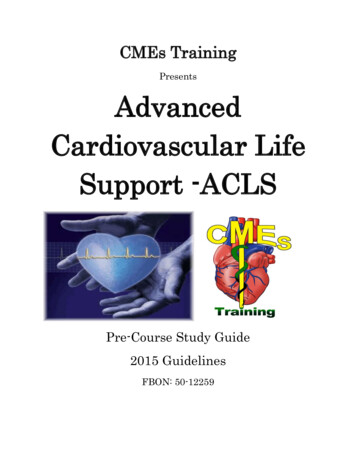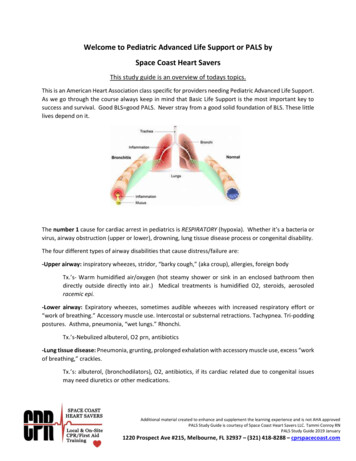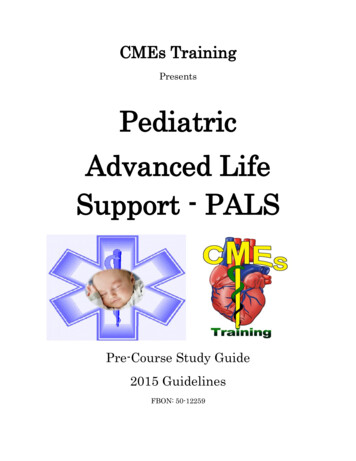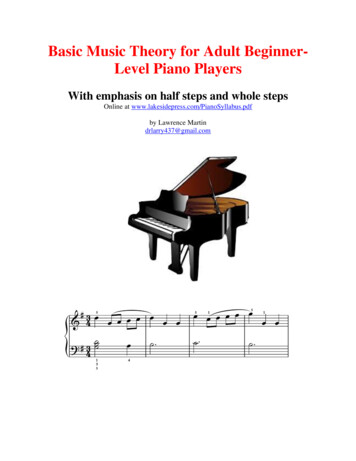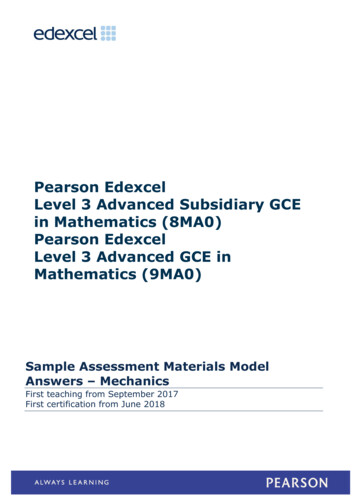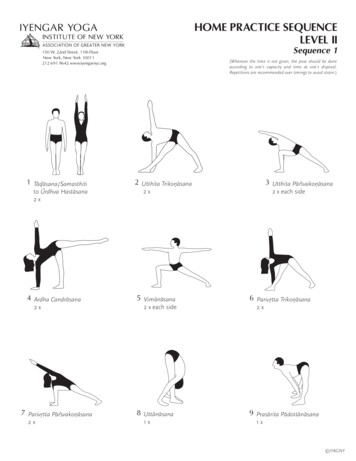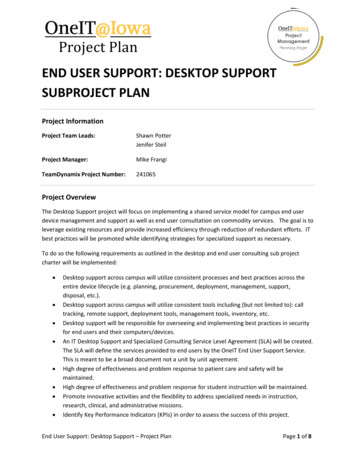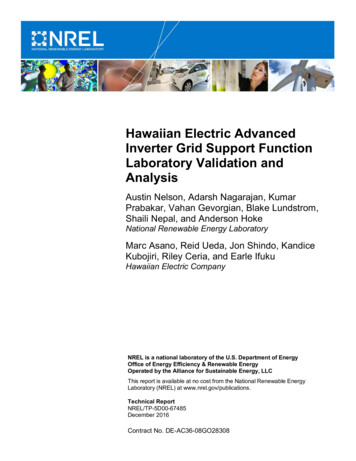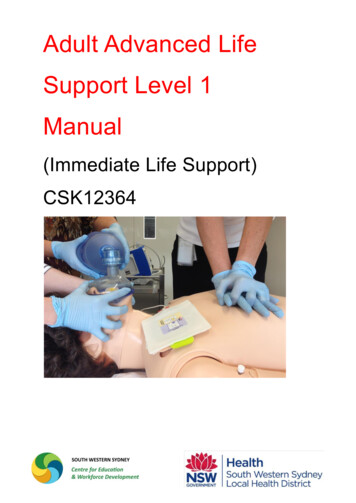
Transcription
Adult Advanced LifeSupport Level 1Manual(Immediate Life Support)CSK12364
South Western Sydney Local Health District, Centre for Education and Workforce DevelopmentThis work is copyright. It may be reproduced in whole or in part for study training purposes subject tothe inclusion of an acknowledgement of the source. It may not be reproduced for commercial usageor sale. Reproduction for purposes other than those indicated above requires written permission fromthe NSW Ministry of Health.Published July 2019South Western Sydney Local Health District (SWSLHD)Centre for Education and Workforce Development (CEWD)Ngara Education CentreLiverpool Hospital, Eastern CampusElizabeth Street, Liverpool NSW 2170Postal address: Locked Bag 7279Liverpool BC NSW tp://intranet.sswahs.nsw.gov.au/CEWD e:(02) 8738 5920Fax:(02) 8738 6858Acknowledgements:Australian Resuscitation Council Guidelines www.resus.org.auV. Palmer & M. Boyd, Organ & Tissue Donation CNC SWSLHDDevelopers:J. Chalmers, Nurse Educator, SWSCEWDA. Hooton, Nurse Educator, SWSCEWDReviewed by:J. Ekholm, Clinical Manager, Cardiovascular and Medical Imaging, SWSLHDS.Goodall, CNE, ICU/HDU Campbelltown HospitalA.Herring, RN, Skills and Simulation Coordinator, Ingham Clinical Skills and Simulation CentreE.Longhurst, CNE, HDU Bowral HospitalK.Owen, CNE, CCU Campbelltown HospitalD.Sanchez, CNC, ICU Campbelltown HospitalDr B Taylor, Conjoint Senior Lecturer UNSW, Simulation Educator, Ingham Clinical Skills and Simulation Centre, EmergencyStaff Specialist, Liverpool HospitalK.Westwood, Nurse Educator, SWSLHD CEWD / HETIL.Wright, A/CNC MET, Campbelltown HospitalVersion Control TableDate ModifiedVersion NumberAugust 94.0Reason for modificationDocument developmentPolicy, brand and coursecode changesChange to pre-requisiteChanges to the ANZCORguidelinesCourse not scheduled forthe past 18 months.Update referencesUpdate MHL requirementsRequested lt ALS Manual Level 1 V4 / SWSCEWDApproved byR. LeonF. LendonF. LendonF. LendonF. Lendon2 of 53
TABLE OF CONTENTSTABLE OF CONTENTS . 3Introduction. 4Chapter 1: Recognising the deteriorating patient . 6Chapter 2: Algorithms . 7Chapter 3: Airway Management and Ventilation . 14Chapter 4: Shockable and non-shockable rhythms . 22Chapter 5: Defibrillation. 27Chapter 6: Pharmacology . 32Chapter 7: Post Resuscitation . 34Chapter 8: Legal and ethical considerations . 38Chapter 9: Communication and Teamwork . 40Chapter 10: Questions for completion prior to workshop attendance . 41Reference / Bibliography . 46Appendix 1 . 50Appendix 2 . 51Adult ALS Manual Level 1 V4 / SWSCEWD3 of 53
IntroductionThis manual forms part of the requirements for the Adult Advanced Life Support (ALS) Level 1 coursein SWSLHD. ALS Level 1 is also known as Immediate Life Support.“Basic Life Support (BLS) is the preservation of life by the initial establishment of, and/ormaintenance of, airway, breathing, circulation and related emergency care, including use ofan AED.Advanced Life Support (ALS) is the provision of effective airway management,ventilation of the lungs and production of a circulation by means of techniques additional tothose of Basic Life Support. These techniques may include, but not be limited to, manualdefibrillation, advanced airway management, vascular access/ drug therapy and defibrillation”(ARC Glossary 2014).The SWSCEWD, Adult ALS Level 1 course consists of: Completion ofo Advanced Life Support Theory- Module A(Adult) (MHL)- course code: 67644403)o Advanced Life Support Theory- Module B (Adult) (MHL – course code: 67644650)o Advanced Life Support Theory – Module C Quiz (MHL- course code 197482978). Reading this manual (SWSLHD Adult ALS Manual) and completing the questions at the endof the manual When the five activities above are completed, attendance at a SWSLHD Face-to-Face oneday Adult ALS workshop CSK12364 Practical assessment CSK12365 by an accredited Adult ALS assessor (either at the one dayworkshop, or at a later date in your facility).The aim of this course is to enhance the knowledge and skills in ALS techniques for those respondingto cardiac arrests within critical care areas. It is suitable for Registered Nurses (RN’s) who work incritical care areas and medical staff.Pre-requisites for attendance at the Adult ALS workshop CSK12364 Completion of Advanced Life Support Theory- Module A (Adult) (MHL - course code:67644403), and Advanced Life Support Theory- Module B (Adult) (MHL - course code:67644650) and Advanced Life Support Theory – Module C Quiz (MHL - course code197482978) within the last 6 months. Basic Life Support Accreditation within the last 12 months For RN’s; currently working in a critical care area Working knowledge of the defibrillator and arrest/resuscitation trolley in their workplace Reading this manual (SWSLHD Adult ALS Manual) and completing the questions at the endof the manualIt is also expected that participants have completed Between the Flags - Tier 2 DETECT ORBetween the Flags - Tier 2 DETECT workshop (Mixed – Face-to-Face) –Nursing and Medical – Half day.In order to simplify treatment regimes, the Australian and New Zealand Committee on Resuscitation(ANZCOR) has produced standardised treatment guidelines based on the recommendations of theInternational Liaison Committee on Resuscitation (ILCOR). These can be found on the ANZCORwebsite, at www.resus.org.au. This course is based on these guidelines.At the end of this course the participant are able to: Discuss and demonstrate airway management with Bag-Valve Resuscitator (BV) Identify shockable and non-shockable rhythms and demonstrate appropriate management Demonstrate knowledge of first-line pharmacological treatment in a cardiac arrest.Adult ALS Manual Level 1 V4 / SWSCEWD4 of 53
Participants are encouraged to seek opportunities to practice their ALS skills and reinforce theknowledge and skills they have learnt through the ALS course process. This should be taking placebefore and after the workshop date.You will need to maintain your BLS and ALS accreditation annually. Reaccreditation consists of: Practical accreditation in BLS with AED (Basic Life Support (Adult) Practical AssessmentCompletion ofo Advanced Life Support Theory- Module A (Adult) (MHL - course code: 67644403)o Advanced Life Support Theory- Module B (Adult) (MHL – course code: 67644650)o Advanced Life Support Theory – Module C Quiz (MHL- course code 197482978).Practical accreditation by an accredited Adult ALS assessor.ALS accreditation and reaccreditation must be recorded in MHL, which enables a standardised andaccessible means of recording and reporting on courses, skills and competencies. For furtherinformation on accreditation for ALS, contact your Clinical Nurse Educator (CNE) or the SWSCEWDNurse Educator (NE) below:Amanda Hooton: amanda.hooton@sswahs.nsw.gov.au 8738 6089Abbreviations used within this manualAEDAutomated External Defibrillator *ILCORAFALSAtrial FibrillationAdvanced Life Support *ILSIOANZCORAustralian and New Zealand Committeeon Resuscitation*Antero PosteriorIVAustralian Resuscitation Council*AtrioVentricular* (official AV audiovisual)Basic Life Support*Bag Valve resuscitatorBetween The Flags*Clinical Excellence CommissionClinical Emergency Response SystemCardio Pulmonary ResuscitationCentral Venous Access Device*LMSMETRMSRNDSNDonation after Brain Death*Donation of tissue / organs after cardiacarrestDetecting Deterioration, Evaluation,Treatment, Escalation andCommunicating in Teams*Do Not ResuscitateDesignated Officer* (official DO DayOnly)Donation Specialist NurseEMDElectro Mechanical Dissociation*SWSCEWDETTFBAOICDICUEndotracheal tubeForeign Body Airway Obstruction*Implantable Cardioverter Defibrillator*Intensive Care CTDNRDOLMAMHLNFRNSWOTDSPEAPPMRCUKInternational Liaison Committeeon Resuscitation*Immediate Life Support*Intra Osseous* (official IO inferior oblique)IntravenousLaryngeal Mask Airway* (officialLMA Left Mento Anterior)Learning Management System*Medical Emergency TeamMy Health LearningNot For ResuscitationNew South WalesOrgan Tissue Donation Service*Pulseless Electrical Activity*Permanent PacemakerResuscitation Council UnitedKingdom*Roads & Maritime Services*Registered NurseROSCReturn of SpontaneousCirculation*SaNOKSVTSenior available Next Of Kin*Supra Ventricular TachycardiaSWSLHDSouth Western Sydney LocalHealth DistrictSouth Western Sydney Centrefor Education and WorkforceDevelopment*Torsades de Pointes*Ventricular TachycardiaVentricular FibrillationAbbreviations with an * are not listed in Approved List of Abbreviations Liverpool Hospital (2018)Adult ALS Manual Level 1 V4 / SWSCEWD5 of 53
Chapter 1: Recognising the deteriorating patientPatients who require ALS often have poor outcomes. ‘Most in-hospital cardiac arrests arenot sudden or unpredictable events. In approximately 80% of cases clinical signs deteriorateover the few hours before arrest’ (ARC & RCUK 2011, p.7).Early recognition, appropriate escalation of care, and effective treatment of the patient whois clinically deteriorating may prevent cardiac arrest, death or an unplanned Intensive CareUnit (ICU) admission.Early recognition of the deteriorating patient is vital. You should be familiar with the simpleassessment and management algorithm: ‘A to G assessment, give oxygen, position yourpatient, call for help’ (CEC, 2014).All public health organisations in New South Wales (NSW) are required to provide a ClinicalEmergency Response System (CERS). It includes the use of NSW Standard Observationcharts with standard calling criteria, an early warning system and rapid response/medicalemergency team, for prompt review and treatment of patients who are clinically deteriorating,with referral to higher levels of care (escalation) when necessary. The aim is to reducecardiac and respiratory arrests and hospital mortality. Although ALS knowledge and skills astaught in this course are vital, it is always better to prevent an arrest where possible.As a result of Australian and International studies, reports and case reviews, the Betweenthe Flags (BTF) and Detecting Deterioration, Evaluation, Treatment, Escalation andCommunicating in Teams (DETECT) programs were implemented in NSW Health in 2010(CEC, 2014). All facilities have policies which outline clinical review and rapid review criteriaso that signs and symptoms of clinical deterioration are recognised and appropriatelymanaged.The A to G assessment is a structured approach to physical assessment. It is quick to useand aims to assist in finding the cause for deterioration rather than just a diagnosis. Usingthe A to G should also help to improve communication of changes in a patient’s condition.A AirwayB BreathingC CirculationD DisabilityE ExposureFFluidsG GlucoseAll clinical staff should be familiar with assessing the patient and recording vital signs,recognising the calling criteria and flagging those patients who need further help. If a patientis deteriorating then there should be an escalation and management plan appropriate for thefacility and the patient.Adult ALS Manual Level 1 V4 / SWSCEWD6 of 53
The chain of survival (American Heart Association, 2014) is a series of actions that link toeach other. Increasing the strength of each link can improve the chances of survival andrecovery for victims of heart attack, stroke and other emergencies. These principles of earlyaccess, early Cardiopulmonary Resuscitation (CPR), early defibrillation and early advancedcare are the foundation of ALS.http://www.wikidoc.org/index.php/File:Chain of survival large.jpgEarly access: Early recognition of the deteriorating patient, immediate recognition of cardiacarrest, and activation of the emergency response systemEarly CPR with an emphasis on chest compressions: Chest compressions andventilations will ensure there is some blood circulated to the patient’s brain, heart and lungs.This helps to reduce further deterioration. DO NOT DELAY CPR in attempts to defibrillate,and minimise interruption
Adult ALS Manual Level 1 V4 / SWSCEWD 6 of 53 Chapter 1: Recognising the deteriorating patient Patients who require ALS often have poor outcomes. ‘Most in-hospital cardiac arrests are not sudden or unpredictable events. In approximately 80% of cases clinical signs deteriorate over the few hours before arrest’ (ARC & RCUK 2011, p.7). Early recognition, appropriate escalation of care, and .
